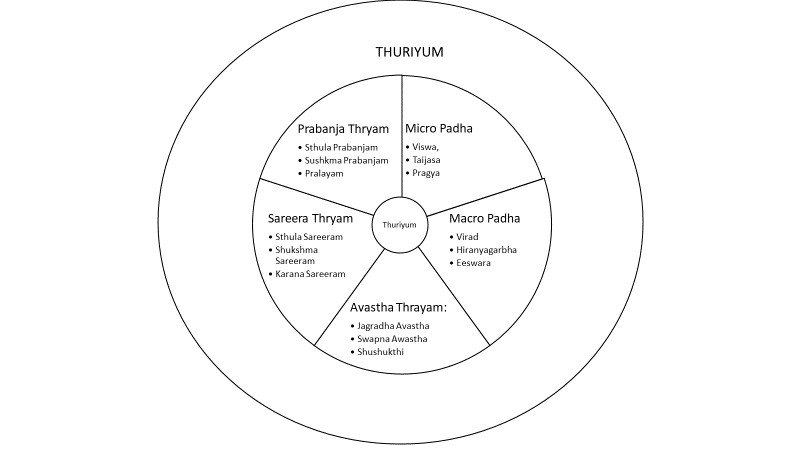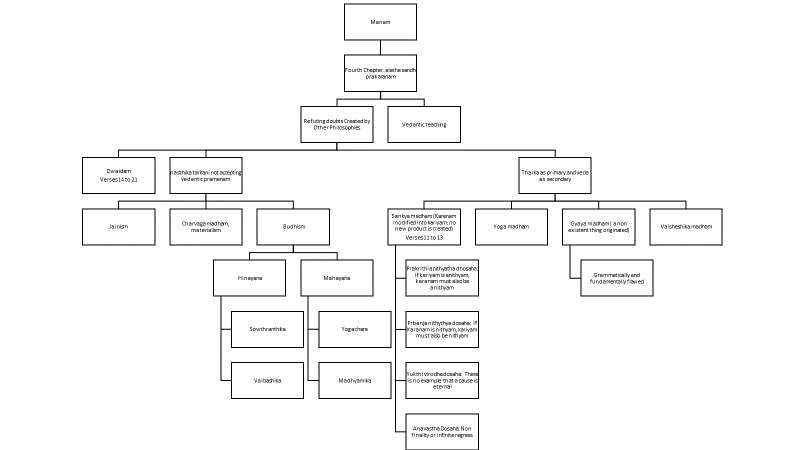Mandukya Upanishdad, Class 53
Advaidam is beyond all
disputes. In vereses 3, 4 and 5 Gowdapadha shows how advaidam doesn’t
have any disputes with other systems of philosophies. The difference of
opinions is primarily was the creation. No system of philosophy is able
to agree with other system and they form rival groups.
The two theories of creation
discussed later are:
- Sath kariya vadhaha: This is sankya philosopher
founded by Kapila Muni. - Asath kariya vadhaha: Founded by gyaya philospher
or vaisheshka philosper.
They argue whether there is an
existent world originated or nonexistent world originated. Advaidin can’t
join either one as he will be attacked by the other. Advaidin do not join
any particular theory of creation. We don’t hold any theory of creation
at all. What is the advadic theory of creation? In advaidam, there
is no theory of creation because there is no creation at all. If I accept
creation, I have to explain the method of creation. What is in front of
us is not a world, but Brahman. What was there was Brahman; and what will
be there is Brahman. Therefore, there is no creation, no theory of
creation.
Sankya philosophers say an existent
product originated. Gyaya philosophers say that an existent product need
not originate at all, therefore a non-existent product originates.
Verse 4
Vaisheshka philosopher refutes
sankya philosopher by saying an existent product can never originate because it
is already existent. Sankya philosophers refute vaisheshaka philosophers
by saying a nonexistent pot can not originate and existent pot need not
originate. Matter can never be created. A nonexistent pot
originates, is grammatically wrong. Action can never exist by
itself. A grammatical sentence requires a verb and subject. In this
sentence the verb is originates. What is the subject of this verb?
According vaisheshika, the subject is nonexistent pot, which means there is no
subject. By refuting each other, they indirectly refuting the origination
of the world. One group refutes the origination of existent pot another
group refutes the origination of nonexistent pot; with the result there is no
question of arrival of pot. This is biggest confusion of human
intellect. Pot has not arrived at all because there is no substance
called pot. The substance is only clay. Pot is not a substance; it
is a word. World is not a substance; it is only a word. There is no
origination of anything other than a new name called world. Any product
is not a substance, it is a new word initiated by your tongue. When
jivatma are not born, where is the question of rebirth? The biggest
samsara is the desire for moksha. I was the paramatma, I am the pramatma
and I ever will be paramatma. There is no coming and joining of
jivatma. It is all confusion and it is Maya.
Verse 5
The non origination of the world is
indirectly supported by both the sankya and gyaya philosphers by refuting each
other. The refuting of creation is the teaching of vedantic
philosophy. We acknowledge their contribution to advaidam. We never
argue with them. The glory of advaida is it is argument free teaching.
Verse 6
The word avivadhah means the advadic
teaching is beyond dispute. This was explained in the verses 3, 4 and
5. From verse 6 to 10, Gowdapadha gives the essence of advaidic perspective.
Advaidin has freed himself from the basic mistake all the philosophers
commit. Freedom from this basic mistake is moksha. Verses 6, 7 and
8 are repetition of the third chapter verses 20, 21 and 22.
The mistake people commit that there
is a paramatma which is the cause of this universe. Paramatma is the
karanam and the universe is kariyam. The world has come from god and we
jivas have also come from god. This jivatma is caught up in the world of
samsara which is full of suffering until the jivatma goes back and merges into
paramatma. Most of the seekers pray only for that “I have come away
from god, at the time of moksha I go back to him”. The fundamental
concept is I have to join god. The day I merge into that Lord, I will be
eternally free or muktha. All these views are entertained without taking
into account, the nature of paramatma. “Eternal paramatma is the
cause of the world” is a logical contradiction. Cause means
modification, eternal means modification free. If the god is the cause,
he can’t be eternal. If God is eternal, he can’t be cause. This is
the fundamental mistake. Jivatma is not a product of paramatma, but
jivatma is none other than paramatma. Making paramatma a cause is not a
glorification of god; it is an insult to god because how can the changeless
paramata ever become the changing cause of the universe.













